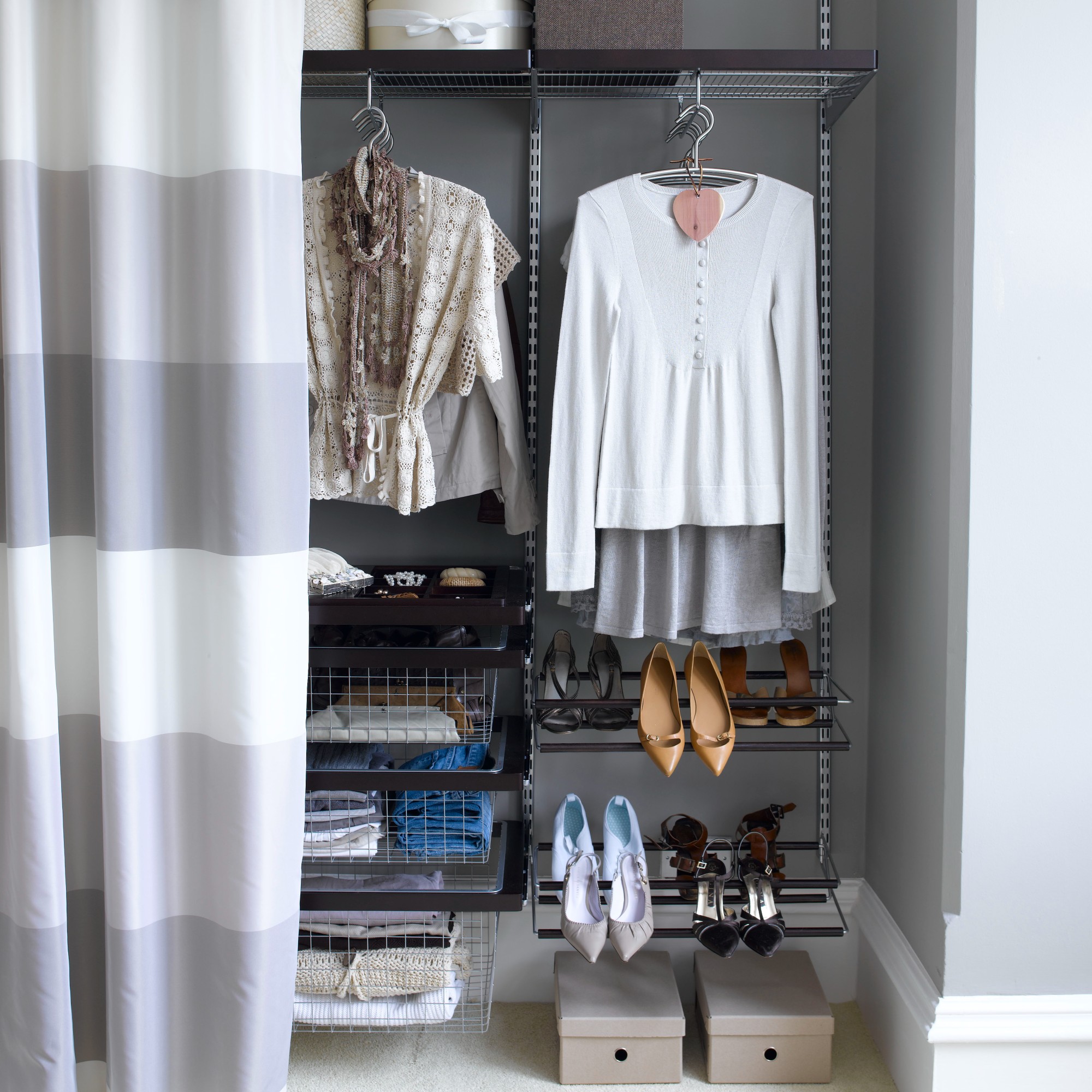How to get rid of moths – 5 steps to get rid of moths in a wardrobe for good
Clear your home of these unwelcome pests with these expert tips

Katie Sims
With the arrival of summer also comes the arrival of clothes-hungry moths. Even if you've spotted one or two moths flitting around your home it is a sign that you could have an infestation and you urgently need to learn how to get rid of moths.
As someone currently battling a moth infestation in my flat, trust me when I say get on top of the problem early if you want to swerve the expense of calling someone in to do a fumigation.
Wardrobe ideas are created more for storage, rather than moth deterrence making them the perfect munching grounds for moths along with carpets. 'Moths are looking for somewhere dark and undisturbed to eat mate and lay their eggs,' explains Julia Dee, the founder of Total Wardrobe Care, an expert on keeping clothes unscathed by moths.
'Carpets rugs and upholstery are good but jumpers stuffed at the back of the wardrobe once or twice worn with hair and skin particles and food splats, pet fur etc is a much more yummy food source for the moth and will attract them to your knits.'

Julia's background is in tailoring and altering clothes for clients. However, as her business grew and clients asked for advice on how to hang, fold and store their clothes and accessories she started to research and develop products to help clothes last and keep them protected from moths when in storage. She has helped organise and protect the wardrobes of Elle Macpherson and Gwyneth Paltrow.
‘Adult clothes moths don’t feed, but their larvae do. They lay their eggs in closets and cupboards full of natural materials,' explains says Martin Seeley, CEO, Mattress Next Day. 'When the eggs hatch, after 4-20 days, they eat the material, and this can leave holes in jumpers, shirts and other high-quality materials.’
If you've spotted signs of larvae in your home - they look like small, cream-coloured caterpillars - it's important to act fast so you can stop them from spreading. UK homes suffer from clothes, carpet and food moths the most, so our guide addresses how to get rid of moths in each of these three areas.
Follow these steps to protect your clothes, furnishings and food from hungry moths.
Sign up to our newsletter for style inspiration, real homes, project and garden advice and shopping know-how
How to get rid of moths in wardrobes

Moths aren't harmful, but they are incredibly annoying if they get into your collection of knitwear in your wardrobe. 'It is more than likely, they will lay their eggs in your knitwear, which will then grow into larvae about the size of a grain of rice and visible to the naked eye,' says Julia. 'The grubs will eat their way out of their cocoon and this is what causes the holes.
When it comes to how to get rid of moths, we really can't stress how important prevention is. If you catch the problem early, this should be enough to get rid of them. However, if the problem is getting out of hand these are the steps to take to get your home moth-free.
1. Deep-clean your wardrobe and your clothes

The telltale signs that you have a moth infestation are signs of larvae, which look like small grains of white rice. Look for webbing and cocoons in the corners of your wardrobe and cupboards.
Give your wardrobe a good vacuum, followed by a wipe down with a damp cloth spritzed with an anti-bacterial spray. Vinegar diluted with water will also work a treat for keeping your wardrobe clean and (hopefully) moth free.
2. Wash and steam clothes

Moth eggs are likely to be lingering among your clothes if you have an infestation. Before you put your clothes back in your clean wardrobe give all of them a good clean.
Moths are especially attracted to stains, sweat and any general mess on clothes, so keeping them clean is paramount in the fight against moths which you can turbocharge with the right detergent and cleaning at the right temperature.
For delicate knits handwash them in laundry liquid that will help repel moths, I'm a big fan of Laundry Liquid from Total Wardrobe Care, which is scented with May Chang that is a traditional remedy for deterring moths. If you're clothes are wash machine safe consider switching to a cedarwood-scented laundry detergent such as Wilton London Laundry Liquid. Cedarwood is another natural scent for deterring moths.
When it comes to the washing machine setting if your clothes can take it clean them on a high heat above 50ºC – the temperature that will start to kill moth eggs or larvae. Alternatively, if you need to wash at a lower temperature you have the option to either steam your clothes to kill any eggs or larvae.
The Tefal AeroSteam Clothes Steamer is a great option as it reaches temperatures of 140º and claims to be 50% faster than traditional handheld steamers.
3. Spray the inside of the wardrobe with moth spray

The final step before putting your clothes back into your wardrobe is to spritz it with a moth killer. There are plenty of effective ones available - just make sure you open a window to ventilate the space after using.
If you're not keen on using chemicals, Total Wardrobe Care offer a moth spray that uses a chrysanthemum formula which is a natural insecticide.
'We recommend spraying this at the bottom of your wardrobe to allow it to rise up through your clothes and keep the doors closed for 24 hours,' says Julia the creator of the Total Wardrobe Care moth spray. 'Replenish every week or so.'
Julia also let us in on a secret, that you can also spritz the top of clothes storage bags before packing knits away for extra moth protection.
Chrysanthemum isn't the only scent you can use, either. There are so many scents that clothes moths hate that you can use to your advantage.
4. Space clothes out

When putting your clothes back in your wardrobe make sure they are spaced out not jammed in. If you haven't managed to leave one lingering moth egg, it will be much harder for it to spread to other clothes when they're spread out.
If you are packing winter clothes away make sure you pop them into clean garment backs and pop a moth repellent in with them for extra measure.
5. Put a moth trap down
To make sure you'v effectively got rid of your moths, pop a moth trap down to monitor the situation. These use pheromones to attract moths and can be picked up from Amazon.
'Keep a moth trap down at all times to monitor moth activity,' says Julia. 'These are brilliant for catching moths and I suggest you put them under your wardrobe. Although moths die out in the wild through the winter once they are in your home, they will carry on living and reproducing.'
You can also purchase moth decoys that use pheromones to disrupt the moth breeding cycle.

How to get rid of moths from carpets

You have been diligent in protecting your wardrobe from moths, but unfortunately that's not the only place they can infest. The winged creatures often lay their eggs in carpets, preferably in areas where the larvae can hatch and feed undisturbed; such as on keratin in the wool.
The damage occurs mostly around the edges of a room, especially if the carpet is shaded or covered by a rug. Open areas with lots of foot traffic and natural light are rarely attacked, so activity on your stair carpet ideas will be along the skirting or stair strings.
To eliminate carpet moths, use a moth spray designed for use on carpets. You need only apply it along the edges, but ensure the treatment reaches the base of the tufts, where the larvae feed, by parting the rows with your hand – repeat after 30 days. If the infestation is serious and you’d like a professional assessment, Rentokil, offers a free survey with advice on treatment.
Going forward, it's key to vacuum regularly, taking care to run under furniture that sits on carpet, or where clothes are stored – for example, under the bed. You could have your carpets professionally cleaned every three months for maximum protection. Consider the same principles for how to get rid of fleas.
Moth Stop Carpet Moth Killer and Freshener Spray 500ml, £13.99 at Lakeland
This Moth Stop spray from Lakeland is designed to be used on carpets invested with moths and larvae. The effects last for up to three months, and it's also been proven to kill carpet beetles and dust mites too. It's lavender scented, so will leave a nice lingering scent on your carpeted floors.
How to get rid of moths from pantries
So we all know about the moths who ruin your favourite jumpers and wool carpets, but did you know there are other species that thrive on food and live in the kitchen? A must-know if you have an on-trend kitchen pantry idea full of dried goods and flours – the very thing these moths are drawn to! Here are out tops tips how to get rid of moths from food pantries.

1. Empty and clean the pantry
The telltale signs that you have a food moth infestation in your kitchen are signs of larvae. Start by emptying the shelves to give them all a through clean with a damp cloth spritzed with an anti-bacterial spray.
The natural cleaning hack using vinegar diluted with water will also work a treat for keeping your pantry clean without the need for harsh chemicals – ideal for kitchen storage ideas where you store food.
2. Ensure everything is air tight
Before you start to put food items back, make sure everything is air tight. Store dried goods in sealed jars and invest in some food preserving clips, like these KitchenCraft Bag Clips, 20 for £4.50 at Harts of Stur, to keep packets closed. The most common food moth is the Indianmeal moth that can infest bread, cereals, flour, spices, rice and other dried goods.

3. Keep old and new produce separate
'Storage jars are great for keeping foods fresher for longer,' says Sophie from Green Protect. 'However, a variety of insects and bugs such as weevil and flour moths can still find their way into them. One way to prevent this is to ensure that new products are not poured on top of old as this can cause insect pest infestation.'
To discourage moth contamination, don't mix old and new produce in storage jars. It's also helpful to label storage jars so you're aware of the expiry date; it's easy to keep dried goods for longer than we should, but this only increases the likelihood of moths wanting to visit your pantry.
FAQs
How do I get rid of moths ASAP?
The first step for learning how to get rid of moths quickly is to give the area of the manifestation a thorough clean. Empty your wardrobe, give it a vacuum and disinfectant with your favourite antibacterial cleaning solution or white vinegar, then wash all your clothes before putting them back in.
If you think moths are already in your wardrobe, giving clothes a steam with a clothes steamer is a great way to make sure any eggs or larvae are killed.
The same applies for manifestations in food pantries or on carpets. Give everything in the vicinity a thorough clean, and follow up with some sort of moth spray, like the NOPE CP Moth Killer Spray (500ml), £12.99 at B&Q. 'Spray this directly onto cupboards, wardrobes, drawers and empty interiors for instant elimination', says Jonathan Kirby, Pest Control Expert, Safeguard Europe.
'It also offers long-lasting protection by creating a barrier on surfaces that kills any moths that come into contact with it for up to three months. For pantries in particular, this solves the worry of needing to frequently spray the areas, which could contaminate food.'
What keeps moths away?
Moth repellents are formulated to deter moths and keep them away, so if your moth problem is severe, it might be worth investing in one of these for an efficient but effective solution. For a more humane alternative, there are some scents that naturally deter moths which you can incorporate into your home, like lavender and cedarwood.
Cedarwood is an excellent natural deterrent against moths so look for moth balls made from this material. You can also buy Cedarwood blocks and hangers to deter moths. Lavender is also known to repel moths so consider using a scented drawer liner that is filled with dried lavender. May Change, which has a lemon aroma is almost a natural moth repellent.
‘Moth repellents give off a scent that deters moths and prevents them from wanting to stick around', says Robert Collins, pest control expert, My Job Quote. 'Clean clothes, particularly dry-cleaned clothes, are great for keeping moths away. The best thing you can do to ensure the moths stay away is to keep on top of your cleaning and avoid leaving dirty clothes or bedding lying around.'
Now you know how to get rid of moths, you can go back to enjoying your home without these bothersome pests!
- Katie SimsContributor
